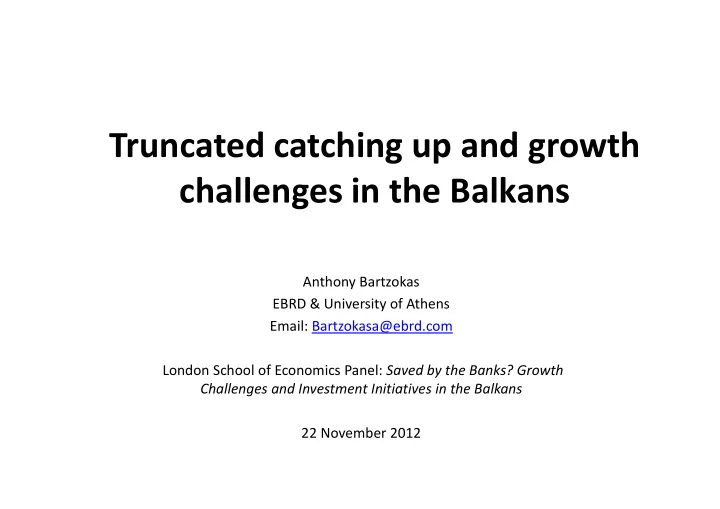

Truncated catching up and growth challenges in the Balkans Anthony Bartzokas EBRD & University of Athens Email: Bartzokasa@ebrd.com London School of Economics Panel: Saved by the Banks? Growth Challenges and Investment Initiatives in the Balkans 22 November 2012
Introduction This presentation was prepared for an LSE public panel on Growth Challenges and Investment Initiatives in the Balkans . We consider medium term growth dynamics in five SEE countries (Albania, Bulgaria, FYROM, Serbia, Romania), where the presence of the Greek business sector is considered to be systemic. While recent policy debates on growth prospects in these countries have emphasized the role of exogenous factors, we propose an interpretation which focuses on (a) the lack of resilient growth drivers, (b) the two main Eurozone crisis transmission channels and (c) the increasing importance of volatility for patterns of (mis)allocation, pricing and utilization of capital in these countries. The policy implications derived from this exercise provide strong support to the IFI Action Plan for Growth and the explicit EBRD priority to address investment coordination failures in SEE. To but things in perspective, recent research on patterns of growth and development suggests that a country that becomes lower-middle-income (that reaches $2,000 per capita income) has to attain an average growth rate of per capita income of at least 4.7 per cent per annum to avoid falling into the lower-middle-income trap (to reach $7,250, the upper-middle-income threshold). This is the case and indeed the current predicament for Balkan economies. ACKNOWLEDGMENTS : This presentation is based on a data set on patterns of growth and Eurozone crisis transmission channels which was prepared with the support of the Bank of Greece and National Bank of Greece. I am grateful to Christos Papazoglou (BoG) and Michael Loufir (NBG) for their generous support. From the EBRD Office of the Chief Economist, Peter Sanfey was always generous with his time and useful insights and Marija Kuzmanovic provided excellent support during the preparation of this presentation
Outline I. Economic growth challenges II. Eurozone crisis transmission channels III. Exogenous volatility, alocation of capital and asset pricing IV. New IFI Action Plan for Growth in CESEE
I. Economic growth challenges • Sluggish post-2007 growth trajectories • Lack of resilient endogenous growth drivers • Slow process of economic diversification and efficiency driven restructuring • Business sector obstacles • The sudden stop of front-loaded financial deepening
EBRD GDP Forecasts Revised Downwards Source: EBRD Regional Economic Prospects May, October 2012
Growth trends since 2007: Quarterly GDP growth (y-o-y) Source: National statistical offices
Annualised output gap* (per cent of potential) Source: National statistical offices *: The annualized output gap is the difference between the annualized (actual or estimated) output (4-quarter rolling sum) and the annualized potential output (4-quarter rolling sum) as percentage of the annualized potential output. The potential output is calculated through the Hoderick-Prescott filter.
Growth Accounting, 2005-2011 Source: Vienna Institute for International Economic Studies (wiiw); IMF country reports
Trade Openness has improved (Exports + Imports of G+S/GDP) Source: Vienna Institute for International Economic Studies (wiiw)
But industrial production trends remain discouraging Industrial Production ( per cent change, y-o-y) *Data for Albania was not available Source: National Statistical Offices
Business development obstacles point out to quality of institutions problems (BEEPS 2008/2009 – per cent deviation from country average) 60% 50% Tax administration Corruption Tax administration Tax administration 40% Tax administration Corruption Corruption Tax administration Infrastructure 30% Courts Courts Corruption Corruption Tax administration Corruption Tax administration Infrastructure Skills 20% Skills Skills Skills Crime Courts Skills 10% 0% Albania BiH Bulgaria Croatia FYR Macedonia Montenegro Romania Serbia Source: EBRD and World Bank, Business Environment and Enterprise Performance Survey IV
Credit growth to the private sector (per cent, y-o-y) Source: National Central Banks
II. Eurozone crisis transmission channels • Exports to the EU • Banking sector deleveraging
Exports to the EU have declined since 2010 (per cent change, y-o-y) Source: Eurostat
Banking sector deleveraging: BIS data Source: Bank for International Settlements
III. Exogenous volatility, alocation of capital and asset pricing • Banking sector loans • FDI stock • Asset pricing trends
Distribution of banking sector loans (end 2011) Source: National Central Banks
FDI Stock Distribution Source: Vienna Institute for International Economic Studies (wiiw); National Central Banks
Asset pricing and stock market indexes Stock Market Index (2008 – end Real Estate Price Index (2006=100), Oct 2012) except FYRoM (2008=100) Source: Emerging Markets Research, National Bank of Greece
IV. New IFI Action Plan for Growth in CESEE EIB, the World Bank and EBRD new Action Plan of over €30 bn ($38 bn) • in 2013-2014. Focus on investment driven growth, not “crisis management” • Elements: • • Special attention to export-led growth and trade integration • Both banking and corporate sector restructuring support for synergies • Acceleration of the use of EU structural funds • Targeted policy advice support (corporate restructuring, NPL/distressed asset management, etc.) • EBRD geographical focus is the Balkans, the hardest hit region.
Recommend
More recommend